
The Arabah, Araba or Aravah is a loosely defined geographic area south of the Dead Sea basin, which forms part of the border between Israel to the west and Jordan to the east.

The Judaean Mountains, or Judaean Hills or the Hebron Mountains, is a mountain range in Palestine and Israel where Jerusalem, Hebron and several other biblical cities are located. The mountains reach a height of 1,026 metres (3,366 ft). The Judean Mountains can be separated to a number of sub-regions, including the Mount Hebron ridge, the Jerusalem ridge and the Judean slopes.

Israeli coastal plain is the coastal plain along Israel's Mediterranean Sea coast, extending 187 kilometres (116 mi) north to south. It is a geographical region defined morphologically by the sea, in terms of topography and soil, and also in its climate, flora and fauna. It is narrow in the north and broadens considerably towards the south, and is continuous with the exception of the short section where Mount Carmel reaches almost all the way to the sea. The Coastal Plain is bordered to the east by – north to south – the topographically higher regions of the Galilee, the low and flat Jezreel Valley, the Carmel range, the mountains of Samaria, the hill country of Judea known as the Shephelah, and the Negev Mountains in the south. To the north it is separated from the coastal plain of Lebanon by the cliffs of Rosh HaNikra, which jut out into the sea from the Galilee mountains, but to the south it continues into the Egyptian Sinai Peninsula.
Biodiversity in Israel and Palestine is about the fauna and flora in the geographical region of Israel and of the State of Palestine. This geographical area within the historical region of Palestine extends from the Jordan River and Wadi Araba in the east, to the Mediterranean Sea and the Sinai desert in the west, to Lebanon in the north, and to the gulf of Aqaba, or Eilat in the south.
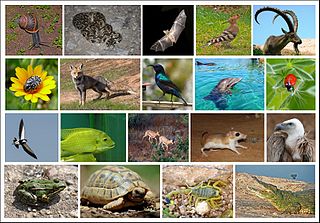
The wildlife of Israel includes the flora and fauna of Israel, which is extremely diverse due to the country's location between the temperate and the tropical zones, bordering the Mediterranean Sea in the west and the desert in the east. Species such as the Syrian brown bear and the Arabian ostrich have become extinct in Israel because of their loss of habitat. As of May 2007, 190 nature reserves have been established in Israel.

Eumannia is a genus of moths in the family Geometridae. It was described by David Stephen Fletcher in 1979.

Catocala puerpera is a moth of the family Erebidae first described by Michel-Esprit Giorna in 1791. It is found in Mediterranean and sub-Mediterranean areas of the Near East and Middle East and in North Africa.

Catocala conversa is a moth of the family Erebidae first described by Eugenius Johann Christoph Esper in 1787. It is found in the Mediterranean zone and parts of the sub-Mediterranean zone.
Cryphia petrea is a moth of the family Noctuidae. It is found from Spain through North Africa to the Near East and Middle East. In the Levant it is found in Lebanon, Jordan and Israel.
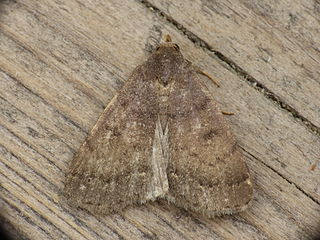
Nodaria nodosalis is a species of moth of the family Erebidae. It is found in tropical Africa, Yemen, Oman, North Africa, Portugal, southern France, Italy, Albania, Bulgaria, Greece, Lebanon and Israel.

Hypena lividalis is a moth of the family Erebidae. It has an Afrotropical and possibly Circumtropical distribution. It is known from the western parts of the Palearctic realm and the Neotropical realm. It is a rare migrant in western, central and northern Europe. In the Mediterranean sclerophyllous forest zone it is widespread and often abundant. In the Levant it has been recorded from Lebanon, Jordan, and Israel.
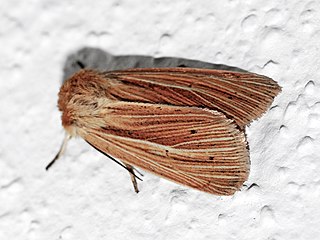
Mythimna congrua is a species of moth of the family Noctuidae.
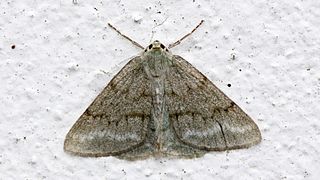
Pseudoterpna coronillaria, the Jersey emerald or gorse emerald, is a moth of the family Geometridae. The species was first described by Jacob Hübner in 1796. It is known from Spain, Portugal, the Pyrenees, western and southern France, Corsica, Sardinia, Sicily, Italy, Samos, Rhodes, Turkey, Israel, Lebanon, northern Jordan and North Africa. It has not been reported from mainland Great Britain, but is present on Jersey, where it was previously overlooked as a form of the grass emerald, until 2001 when it was correctly identified.

Lithostege farinata is a moth of the family Geometridae. It is found from the Iberian Peninsula through north-eastern Germany east to eastern Europe and the Caucasus to western Siberia and Central Asia. In the north, it ranges to southern Scandinavia and the Baltic States. In the south, it is found up to southern Italy and the Balkan Peninsula. It has also been recorded from south-eastern Turkey and north-western Africa. There are old records from Israel and Egypt.
Depressaria marcella is a moth of the family Depressariidae. It is found in France, Spain, Portugal, Slovakia, Hungary, Croatia, Romania, Bulgaria, North Macedonia, Greece and Turkey and on Sardinia and Sicily. It has also been recorded from Israel, Iran and North Africa.
Depressaria tenebricosa is a moth of the family Depressariidae. It is found in Spain, Portugal, Italy, Croatia, Romania, North Macedonia and Greece. It has also been recorded from Israel and Asia Minor.

Scopula beckeraria is a moth of the family Geometridae. It was described by Julius Lederer in 1853. It is found in Italy, Croatia, North Macedonia, Greece, Bulgaria, Romania, Ukraine, Russia, Turkey, Armenia, Israel, Lebanon, Iran, Turkmenistan and Kazakhstan.

Acossus terebra is a species of moth of the family Cossidae. It is found in Eurasia, including Israel, Turkey, northern Spain, central and southern Europe, southern Sweden, Finland, the Baltic region, Ukraine, the central part of European Russia, the Caucasus, southern Siberia to southern Yakutia, the southern part of the Russian Far East, Korea, Heilongjiang, Jilin and inner Mongolia.
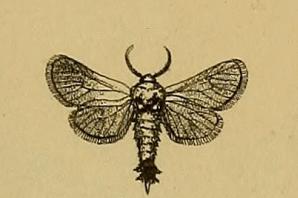
Stygioides colchica is a species of moth of the family Cossidae. It is found in Bulgaria, Greece, the southern part of European Russia, Ukraine, Turkey, Armenia, Lebanon and Israel.

Aporophyla canescens is a moth of the family Noctuidae. It was described by Philogène Auguste Joseph Duponchel in 1826. It is found in Italy, Switzerland, Slovenia, Croatia, Albania, Bosnia and Herzegovina, Serbia, North Macedonia, Greece, Turkey, Israel, Portugal, Russia, as well as on Sardinia, Corsica, Sicily, Malta and Crete.













